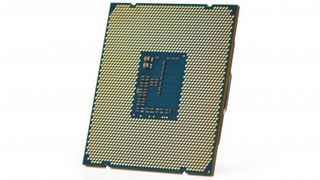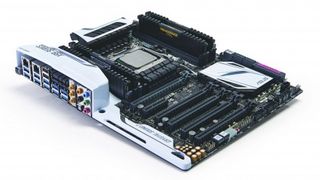TechRadar Verdict
A fantastically powerful multi-threading CPU, offering a genuine step-change over and above the current PC platforms. available.
Pros
- +
Great multi-threading performance, impressively cool-running, hefty eight-core overclocking
Cons
- -
Super-expensive, no real gaming boost
Why you can trust TechRadar
Intel's Core i7-5960X is its first ever eight-core processor for the general public. You could have bought a vastly more expensive octocore Xeon to drop into an old PC, but this is the full Core monty.
And it's a bit special.
There sure is a lot of silicon given over to the graphical components of most of today's other processors though. Intel's standard Haswell architecture throws millions of transistors at its HD graphics component, and AMD's latest Kaveri chips are only a couple of percentage points from being a complete half-and-half split between processor and graphics.
For us enthusiast-type folk, though – more used to strapping a big shiny graphics card to our motherboard than relying on weak-heart integrated GPUs – that's a lot of redundant die space we're paying for.
It also sounds like an awful lot of space we could be shoving extra CPU cores into, doesn't it?
And that's exactly what Intel's high-performance CPU range has been doing for the last few years. The Extreme line of Intel's processors represents the pinnacle of its desktop chips, cramming in more cores than any desktop chip available. For the most part, anyway.
But despite shrinking in production process, even the Extreme range has been stuck fast at six cores for a long while. That's despite AMD already banging the octo-core drum – albeit to little effect – and Intel's own server parts rocking six cores and 12 threads over four years ago.
Finally though, Intel has decided to up the ante on its Extreme consumer chips and is giving us a bona fide eight-core processor with the top end of its new Haswell-E processors.
The Core i7-5960X is that chip, and is the first octo-core chip with Intel's powerful Core architecture squeezed inside.
Well…kinda.
You could have actually gone super-extreme with the previous Sandy Bridge E generation of Extreme chips and dropped a super-expensive eight-core Xeon directly into a standard X79 desktop motherboard. We're going to copyright the term 'super-extreme' by the way; some enterprising marketing exec is bound to try and tack that on to some stupidly expensive component some day, and we need a way to stop them.
Anyway, the old Xeon E5‑2687W was a 32nm mega-chip.
It gave us our first taste of eight proper Intel cores in one chip back in 2012, and in doing so engendered the disappointment of last generation's Ivy Bridge E chips, still stalling on six cores.
Two and a bit years later we've finally got the i7-5960X and its unlocked multiplier giving us the full desktop eight-core, 16-thread monty. It's running on the latest Intel Haswell Core architecture, the new micro-architecture design for the 22nm production process first displayed by the Ivy Bridge processors.
Haswell debuted over a year ago, and in the intervening time has frimly cemented its place in the top desktop PCs around, especially after the recent Devil's Canyon refresh.
Now, though, Haswell E is set to take our high-end desktops to the next level, offering unprecedented processing performance.

Sweet sixteen
Let's take a closer look at this new CPU, then.
We already know it's rocking eight Intel cores, and because this top chip is taking advantage of Hyper-Threading that translates into a full 16 threads of processing power. We couldn't help but break into a great big geeky grin watching the Cinebench test split over 16 chunks and chew through the benchmark faster than anything we'd seen before.
It's also completely unlocked – as any good Extreme Edition CPU should be – and contains a full 40 PCIe 3.0 lanes. What's more, there's a huge 20MB of cache. The only real let-down when you take a first look at the specs, then, is that operating frequency.
With a baseclock of just 3GHz and a Turbo speed of up to 3.5GHz, it looks a little off the pace when you compare it with the 3.6GHz/4GHz configuration of the last Ivy Bridge-E processor.
We've also just had Intel itself releasing the i7-4790K processor with a baseclock of 4GHz, which also serves to make this brand new, hyper-expensive CPU look somewhat lethargic in the clockspeed department.
But that's a little unfair, really – being able to run all eight of those cores at a Turbo of 3.5GHz is nothing to be sniffed at and the lower baseclock is likely a result of making sure Intel can produce reliable yields of these 22nm CPU dies, with all eight cores running stably.
With a chip requiring more functional physical cores in a die, there's a greater chance of it dropping out of the manufacturing process with one of them functioning sub-optimally. Pulling the clockspeed back a touch, then, means Intel has better odds of producing these expensive parts in a decent volume.
As we've said, the new Haswell-E chips are all unlocked, and if you're lucky you'll be able to get a hefty performance boost by upping those clockspeeds in your motherboard of choice.

And the new motherboards play a pivotal role in this new high-performance story too; the processors themselves are only one part of it.
Haswell-E is a whole new computing platform, offering a genuinely different proposition over the standard quad-core setups and even over the last generation of Extreme Intel platforms.
Accompanying the new Haswell-E processors is the X99 platform and with that comes support for new storage interfaces and a brand new standard in system memory: DDR4.
The new memory standard remains in the same quad-channel configuration as Intel has used with the other LGA 2011-based platforms, but offers a considerably lower operating voltage than DDR3. Most quad-channel kits are running at 1.5v, but the modules we've been testing this month are more than happy running at serious speeds with just a 1.2v base. With the X99 chipset, DDR4 RAM also starts out with a 2,133MHz baseclock, which is a good deal quicker than the 1,866MHz of the Ivy Bridge-E generation of processors.

